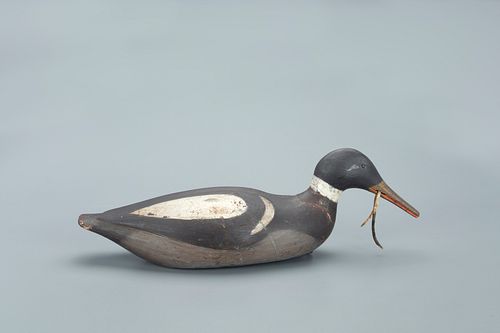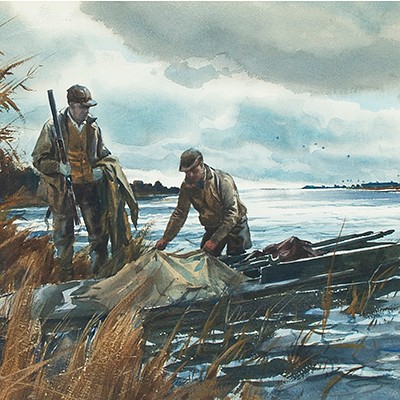Rare Feeding Merganser Drake Decoy, Augustus “Gus” Aaron Wilson (1864-1950)
About Seller
65 Sharp Street
Hingham, MA 02043
United States
Copley Fine Art Auctions is the world's leading American sporting art auction company. Located in Hingham, MA, Copley specializes in antique decoys and 19th- and 20th-century American, sporting, and wildlife paintings. Principal Stephen O'Brien Jr., a fourth-generation sportsman with a refined colle...Read more
Two ways to bid:
- Leave a max absentee bid and the platform will bid on your behalf up to your maximum bid during the live auction.
- Bid live during the auction and your bids will be submitted real-time to the auctioneer.
Bid Increments
| Price | Bid Increment |
|---|---|
| $0 | $50 |
| $1,000 | $100 |
| $2,500 | $250 |
| $5,000 | $500 |
| $10,000 | $1,000 |
| $25,000 | $2,500 |
| $50,000 | $5,000 |
About Auction
Mar 5, 2022
Lots 265-556 Copley Fine Art Auctions cinnie@copleyart.com
- Lot Description
Rare Feeding Merganser Drake
Augustus “Gus” Aaron Wilson (1864-1950)
South Portland, ME, c. 1900
20 1/2 in. long
“Maine’s greatest and most prolific carver was Augustus Aaron “Gus” Wilson... Wilson had few equals among decoy makers as a sculptor, only his contemporary Ira Hudson in Virginia carved so wide a variety of forms. Wilson carved both heads and bodies freehand, holding the piece of wood in his hands, and this approach allowed him the tactile immediacy that characterizes his work. His best birds are at once powerful and imaginative.” — Robert Shaw, "Bird Decoys of North America"
Merganser decoys have always held a special place amongst carvers and collectors of decoys and folk art. The species’ animated forms and striking plumage lend themselves to artistic designs of virtually endless interpretations. Makers and collectors have been captivated by these seemingly playful diving birds, making them among the most celebrated of all decoys.
Wilson was born “Down East,” on Mount Desert Island, Maine. Though he is foremost remembered as a carver, Wilson was also a boatbuilder, waterman, outdoorsman, and a lighthouse keeper. He was an attendant to a number of Maine’s lighthouses, including the Marshall Point Light at Port Clyde, Great Duck Island Light, Goose Rocks Station on Fox Island, Two Lights Station on Cape Elizabeth, and Spring Point Light in Casco Bay.
Wilson’s interests were by no means limited to decoys. He carved a variety of songbirds, decoratives, weathervanes, and big cats. A pair of Wilson tigers is featured in the American Identities exhibit, on display as a part of the permanent collection at the Brooklyn Museum in Brooklyn, New York.
This rare merganser sculpture showcases the decoy as American folk art. The body has bold, raised wing carving and the inletted head is in a reaching position. A strip of leather is held through a slot in the base of the bill to represent a morsel of food. Wilson’s attention to anatomy is commendable, with the inside of the lower bill accurately painted red. The intricate bill’s survival is remarkable given the bird’s use as a hunting decoy. The underside is inscribed “Chester Marshall, Marshall Point Light House, Port Clyde, Maine.”
Original paint with even gunning wear. A few old paint drips. Tight age line in back of neck.
Provenance: Private Collection, New York
Literature: Robert Shaw, “Bird Decoys of North America,” New York, NY, 2010, pp. 147-149. Robert Bishop, "American Folk Sculpture," New York, NY, 1985, p. 302, pl. 560, related mallard illustrated. Alan G. Haid and Brandy S. Culp, “The Allure of the Decoy: Historic Charleston Foundation Presents Masterworks from the Collection of Mr. and Mrs. Alan G. Haid,” Charleston, SC, 2013, p. 15, rigmate illustrated. Richard A. Bourne Co., Inc., "Rare American Decoys & Bird Carvings," Hyannis, MA, February 1 & 2, 1985, front cover and lot 117A, rigmate illustrated.Please email condition report requests to colin@copleyart.com. Any condition statement given is a courtesy to customers, Copley will not be held responsible for any errors or omissions. The absence of a condition statement does not imply that the lot is in perfect condition.Condition
- Shipping Info
-
Copley Fine Art Auctions does not handle the shipping of any items. Shipping is the sole responsibility of the buyer. Once your payment has cleared, and we have received your authorized shipping release form items may be released for shipment. Copley Fine Art Auctions, LLC shall have no liability for any loss or damage to such items. Buyers should allow up to four weeks for shipment.
-



 EUR
EUR CAD
CAD AUD
AUD GBP
GBP MXN
MXN HKD
HKD CNY
CNY MYR
MYR SEK
SEK SGD
SGD CHF
CHF THB
THB














